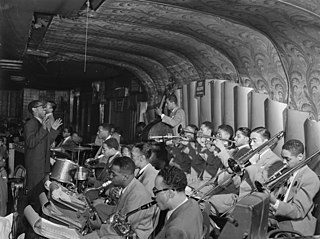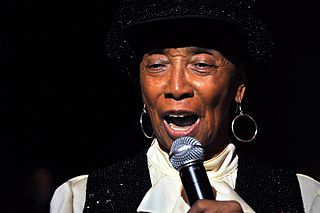Related Research Articles

The Savoy Ballroom was a large ballroom for music and public dancing located at 596 Lenox Avenue, between 140th and 141st Streets in the Harlem neighborhood of Manhattan, New York City. Lenox Avenue was the main thoroughfare through upper Harlem. Poet Langston Hughes calls it the "Heartbeat of Harlem" in Juke Box Love Song, and he set his work "Lenox Avenue: Midnight" on the legendary street. The Savoy was one of many Harlem hot spots along Lenox, but it was the one to be called the "World's Finest Ballroom". It was in operation from March 12, 1926, to July 10, 1958, and as Barbara Englebrecht writes in her article "Swinging at the Savoy", it was "a building, a geographic place, a ballroom, and the 'soul' of a neighborhood". It was opened and owned by white entrepreneur Jay Faggen and Jewish businessman Moe Gale. It was managed by African-American businessman and civic leader Charles Buchanan. Buchanan, who was born in the British West Indies, sought to run a "luxury ballroom to accommodate the many thousands who wished to dance in an atmosphere of tasteful refinement, rather than in the small stuffy halls and the foul smelling, smoke laden cellar nightclubs ..."
An Aerial is a dance move in Lindy Hop or Boogie Woogie where one's feet leave the floor. As opposed to a lift, aerial is a step where a partner needs to be thrown into the air and then landed in time with the music. Each aerial consists of a preparation ('prep'), jump or trick itself and the landing.

Swing dance is a group of social dances that developed with the swing style of jazz music in the 1920s–1940s, with the origins of each dance predating the popular "swing era". Hundreds of styles of swing dancing were developed; those that have survived beyond that era include Charleston, Balboa, Lindy Hop, and Collegiate Shag. Today, the best-known of these dances is the Lindy Hop, which originated in Harlem in the early 1930s. While the majority of swing dances began in African-American communities as vernacular African-American dances, some influenced swing-era dances, like Balboa, developed outside of these communities.

The Shim Sham Shimmy,Shim Sham or just Sham originally is a particular tap dance routine and is regarded as tap dance's national anthem. For today's swing dancers, it is a line dance.
The Big Apple is both a partner dance and a circle dance that originated in the Afro-American community of the United States in the beginning of the 20th century.
Some films feature recognizable dance forms, demonstrating them, shedding light on their origin, or being the base of a plot.

Jitterbug is a generalized term used to describe swing dancing. It is often synonymous with the lindy hop dance but might include elements of the jive, east coast swing, collegiate shag, charleston, balboa and other swing dances.

Frank Manning was an American dancer, instructor, and choreographer. Manning is considered one of the founders of Lindy Hop, an energetic form of the jazz dance style known as swing.

Blues dancing is a family of historical dances that developed alongside and were danced to blues music, or the contemporary dances that are danced in that aesthetic. It has its roots in African-American dance, which itself is rooted in sub-Saharan African music traditions and the historical dances brought to the United States by European immigrants.

The Hot Shots is a collective name for two closely related Swedish dance companies based in Stockholm, Sweden: The Rhythm Hot Shots and the Harlem Hot Shots. The Hot Shots specialize in faithful reproductions of African-American dance scenes in American films from the 1920s, 30s, and 40s. Dances that they perform include Lindy Hop, Tap dance, Cakewalk, Charleston, and Black Bottom. The members of the Hot Shots are also respected dance instructors and accomplished social dancers. The goals of The Rhythm Hot Shots and the Harlem Hot Shots are the same.
Dean Collins was an American dancer, instructor, choreographer, and innovator of swing dance. He is often credited with bringing the Lindy Hop from New York to southern California and influencing the development of West Coast Swing. Collins worked in over thirty films and performed live and on television.
Whitey's Lindy Hoppers was a professional performing group of exceptional swing dancers that was first organized in the late 1920s by Herbert "Whitey" White in the Savoy Ballroom and disbanded in 1942 after its male members were drafted into World War II. The group took on many different forms and had several different names and sub-groups, including Whitey's Hopping Maniacs, Harlem Congeroo Dancers, and The Hot Chocolates. In addition to touring nationally and internationally, the group appeared in several films and Broadway theatre productions. Dorothy Dandridge and Sammy Davis Jr. were among the group's celebrity regulars.

You Were Never Lovelier is a 1942 American musical romantic comedy film directed by William A. Seiter and starring Fred Astaire and Rita Hayworth. The supporting cast also features Adolphe Menjou, Xavier Cugat and Adele Mara. The music was composed by Jerome Kern and the lyrics by Johnny Mercer. The picture was released by Columbia Pictures and includes the elaborate "Shorty George" and romantic "I'm Old Fashioned" song and dance sequences.
Al Minns, was a prominent American Lindy Hop and jazz dancer. Most famous for his film and stage performances in the 1930s and 1940s with the Harlem-based Whitey's Lindy Hoppers, Minns worked throughout his life to promote the dances that he and his cohorts helped to pioneer at New York's Savoy Ballroom. In 1938, Al Minns and Sandra Gibson won the Harvest Moon Ball.
Alfred "Pepsi" Bethel was a jazz dancer, choreographer, and leader of his own dance troupe, the Pepsi Bethel Authentic Jazz Dance Theater, which he founded in 1960.

The history of Lindy Hop begins in the African American communities of Harlem, New York during the late 1920s in conjunction with swing jazz. Lindy Hop is closely related to earlier African American vernacular dances but quickly gained its own fame through dancers in films, performances, competitions, and professional dance troupes. It became especially popular in the 1930s with the upsurge of aerials. The popularity of Lindy Hop declined after World War II, and it converted to other forms of dancing, but it never disappeared during the decades between the 1940s and the 1980s until European and American dancers revived it starting from the beginning of the 1980s.

Norma Adele Miller was an American Lindy hop dancer, choreographer, actress, author, and comedian known as the "Queen of Swing".

The Lindy Hop is an American dance which was born in the African-American communities of Harlem, New York City, in 1928 and has evolved since then. It was very popular during the swing era of the late 1930s and early 1940s. Lindy is a fusion of many dances that preceded it or were popular during its development but is mainly based on jazz, tap, breakaway, and Charleston. It is frequently described as a jazz dance and is a member of the swing dance family.
George Reed Wilbourn was an American jazz drummer and singer who performed as George Reed.
Willa Mae Ricker was a prominent American Lindy Hop and jazz dancer and performer during the 1930s and 1940s with the Harlem-based Whitey's Lindy Hoppers. She was known for her physical strength, fashion sense, dependability, business acumen, and passion to dance. According to Norma Miller, Ricker was the first dancer to stand up to Herbert "Whitey" White, demanding fair pay.
References
- ↑ George Snowden’s career in dancing is discussed, in particular, Terry Monaghan’s George Snowden article, and Harri Heinilä’s doctoral dissertation. See: Terry Monaghan, 'George Snowden', The Dancing Times, July 2004. The article is republished at http://jassdancer.blogspot.fi/2012/10/shorty-george-snowden.html . Harri Heinilä, An Endeavor by Harlem Dancers to Achieve Equality – The Recognition of the Harlem-Based African-American Jazz Dance Between 1921 and 1943, pages 135-138. Heinilä published also an article of George Snowden and Mattie Purnell where they are discussed concerning their invention. The article can be found at https://authenticjazzdance.wordpress.com/2012/07/04/the-creators-of-the-lindy-hop-george-shorty-snowden-and-mattie-purnell/ .
- ↑ Peter BetBasoo has discussed the Lindy Hop dances which existed before the Harlem Lindy Hop. See: Peter BetBasoo, Lindy Hop and Argentine Tango, copyright Peter BetBasoo, published in the Internet, 2009.
- ↑ See: Monaghan 2004 and Heinilä 2016, pages 138-141.
- ↑ See: Monaghan 2004 and Heinilä 2016, pages 148, 165-168.
- ↑ See: Monaghan 2004.